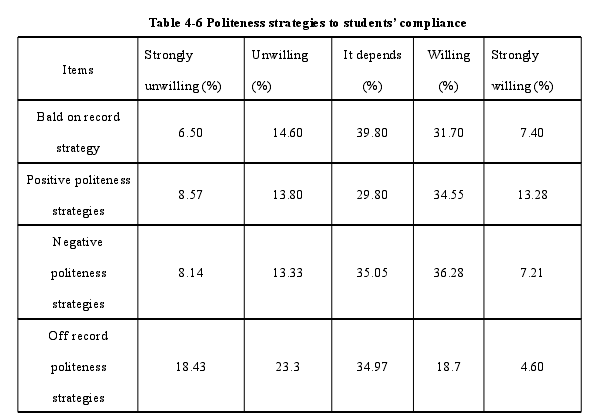英语论文哪里有?本研究的发现为高中英语教学提供了一些启示。通过强调教师话语在课堂互动中的重要性,提出了一些对英语教学的启示。
Chapter One Introduction
1.2 Purpose of the Study
Most of the previous studies are conducted to explore teachers’ politenessstrategies, that is, teachers’ preference of politeness strategies (Xu, 2003; Khusnia,2017; Darong, Kadarisman & Basthomi, 2020), gender differences on politenessstrategies (Monsefi & Hadidi, 2015;Arif et al., 2018;Batcha, Bahous & Diab, 2012),influence of teachers’ politeness strategies to students (Hu & Dai, 2009; Li, 2011;Chen & Zhou, 2012; Kang, 2012; Liu, Fang & Liang, 2014; Tan 2019). Hopefully,some research (Zhang, 2009; Manik & Hutagaol, 2015; Fitriyah et al., 2020) begun toexplore how teachers’ politeness strategies impact students’ compliance. However,most of them are targeted at college students, the results of which are not suitable forsenior high school.
Considering the above-mentioned limitations of previous studies, this study aimsto investigate the employment of teachers’ politeness strategies in senior high schoolthrough classroom observation. In this study, according to the categorization putforward by Jiang (2010), teacher’s talk is classified into four types, namely academicinstruction, motivation, evaluation and classroom management, so as to explore theemployment of politeness strategies. What’s more, attention is also paid to howpoliteness strategies influence students’ compliance. More specifically, with the helpof questionnaire and interview, this study investigates how students’ compliancevaries according to the diverse politeness strategies employed by teachers in seniorhigh school.
Chapter Three Research Design
3.1 Research Questions
The research questions are formulated as:
(1) What types of politeness strategies are adopted by the teachers to the studentsin teaching process of the three schools in H city?
(2) Do teacher’s politeness strategies affect students’ compliance? What’s therelationship between teacher’s politeness strategies and students’ compliance?
Participants of this research are ten teachers and students from three senior highschools in H city ranging from grade ten to grade eleven. To be more specific, threeteachers are from school A and another three come from school B. The left fourteachers are from school C. These teachers selected in the three schools are of diverseage, English proficiency, professional title and academic degree. The detailinformation of the ten teachers is listed as follows:
Chapter Four Results and Discussion
4.1 Results and Discussion of Classroom Observation
For the purpose of making it clearer about the different proportion of politenessstrategies employed in teachers’ discourse, the research mainly adopted the methodused by Jiang (2010) who defined teachers’ discourse from the perspective offunctions of language as academic instruction, motivation, evaluation and classroommanagement. In the following parts, it firstly discusses about the overall applicationof politeness strategies in senior high school English classes and then analyzes thepoliteness strategies in different types of discourse. The following table presents thefrequency and proportion of politeness strategies used by the teachers.

4.2 Results and Discussion of the Questionnaire
In order to investigate the influence of teachers’ politeness strategies on students’compliance, the author devised a questionnaire. After data collection, tables in thefollowing present the results of questionnaire:

The table above shows the overall situation of teachers’ politeness strategies onstudents’ compliance. As the table states, compared with other politeness strategies,students are more likely to comply with teachers when teachers employ positivepoliteness strategies. However, a large part of the students (34.55%) who wouldcomply with teachers just choosing “willing” instead of “strongly willing” whenteachers use positive politeness strategies. More interestingly, when teacher used themost politeness strategies-off record politeness strategies only 23.3% of students arewilling to comply with teachers, making it the least. Besides, the rates of students’unambiguous attitude (“it depends”) to teachers’ politeness strategies are high in thefour politeness strategies. The following parts demonstrate the concrete statistics ofeach strategy.
Chapter Five Conclusions and Suggestions
5.1 Major Findings
The present study sets out to investigate the overall situation of the senior highschool English teachers in applying politeness strategies in teachers’ discourse in theclassroom. In addition, it investigates the influence of teacher talk on students’compliance. Based on the analysis and discussion, the major findings are summarizedas followed:
Research Question 1:
What types of politeness strategies are adopted by the teachers to the students inteaching process of the three schools in H city?
Teachers employ diverse types of politeness strategies in different classroomdiscourse, and its frequency from high to low ranks as positive politeness strategy(58.86%), bald on record strategy (26.93%), negative politeness strategy (12.46%)and off record politeness strategy (1.75%).
As for types of politeness strategies used in teachers’ discourse, the teacher has apreference of using politeness strategies in different discourse. More specifically, inacademic instructions, positive politeness strategy (58.5%) is the most frequently usedstrategies while off record politeness strategy (0.6%) is the least. Similarly, inmotivation acts, positive politeness strategy (57.7%) is most commonly used inmotivation. On the contrary, off record politeness strategy (4.4%) is the least. While inevaluation acts, positive politeness strategies (77.3%) are still the most commonlyused politeness strategies but off record strategy disappeared. However, in classroom management acts, bald on record strategy has a high proportion (70%) of all but noemployment of off record politeness strategy was found. In short, positive politenessstrategy is the most frequently used in the observed classes, while bald on recordstrategy is the dominant type in classroom management acts.
reference(omitted)

